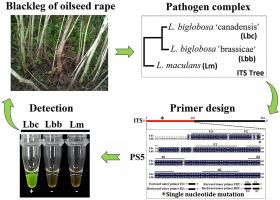Crop Protection ( IF 2.8 ) Pub Date : 2021-03-08 , DOI: 10.1016/j.cropro.2021.105610 Ran Du , Tao Luo , Jing Zhang , Long Yang , Mingde Wu , Guoqing Li

|
The ascomycetous fungus Leptosphaeria biglobosa (Lb) and its sibling L. maculans (Lm) constitute a species complex responsible for blackleg of oilseed rape. L. biglobosa is composed of at least seven phylogenetic sub-clades, including L. biglobosa ‘brassicae’ (Lbb) and L. biglobosa ‘canadensis’ (Lbc), which widely distribute in America, Australia and Europe. So far, only Lbb has been reported in China, and recent surveys showed that Lbc widely occurred in Northern China. In order to track the spread of Lbc in this country, a simple and rapid diagnostic tool was developed based on loop-mediated isothermal amplification (LAMP) in this study. A total of 11 primer sets targeting the internal transcribed spacer region of the ribosomal DNA of Lbc were designed, and screened based on their performance in initiation of LAMP reactions for Lbc (65 °C, 40 min). The primer set PS5 with an introduced T-to-A mutation could efficiently and persistently detect Lbc. Then, specificity and sensitivity of PS5 was tested using the DNA from Lbb, Lbc, Lm, and 9 other fungi. The results showed that PS5 was specific to Lbc, and highly sensitive with the detection threshold of the Lbc DNA as low as 988 fg per reaction. The utility was evaluated using the DNA from healthy and Lbc-infected stems of oilseed rape, and the result showed that the LAMP assay positively detected the DNA from Lbc-infected stems. The LAMP technique developed herein will help to monitor populations of the blackleg pathogens and for developing strategies for management of the blackleg disease.


























 京公网安备 11010802027423号
京公网安备 11010802027423号